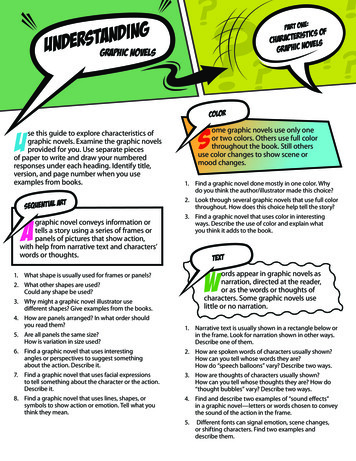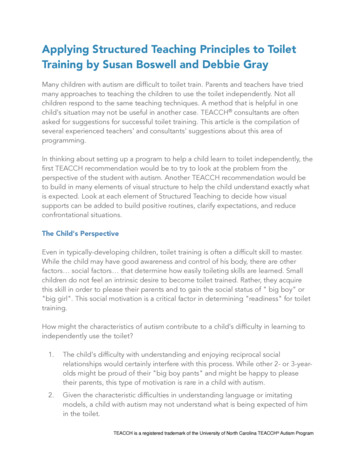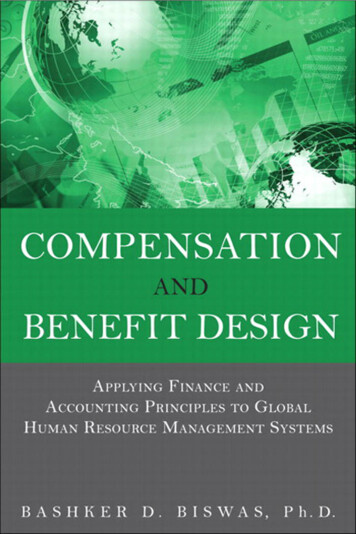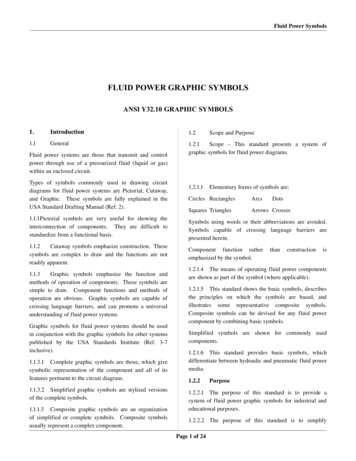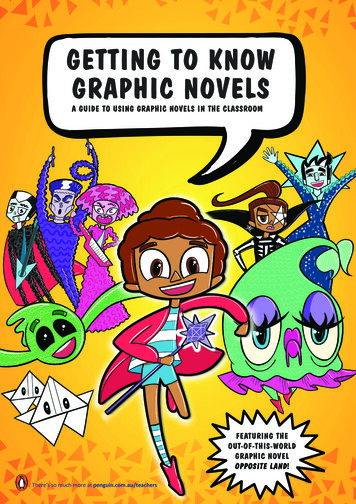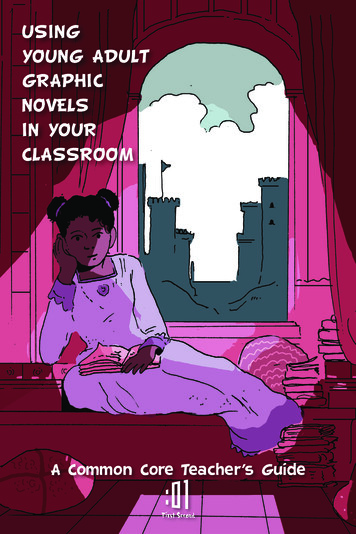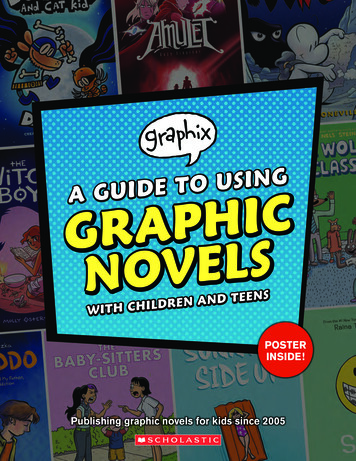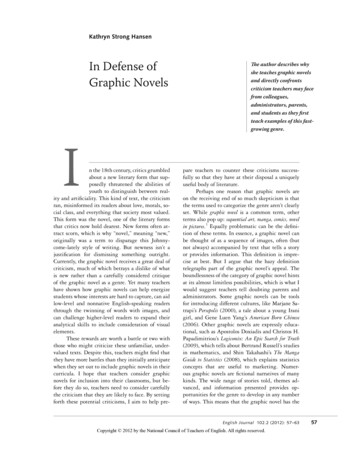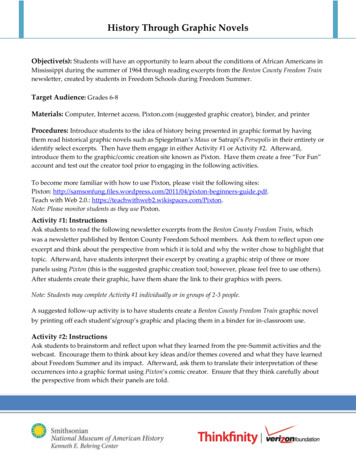
Transcription
https://doi.org/10.24867/GRID-2020-p64Original scientific paperAPPLYING GRAPHIC DESIGN PRINCIPLES ON TEA PACKAGINGDorotea Kovačević , Maja Brozović , Dubravko BanićUniversity of Zagreb, Faculty of Graphic Arts, Zagreb, CroatiaAbstract: The aesthetic aspect of product packaging is a well-known factor in attracting consumers’attention. One of the most common ways in achieving the aesthetic appearance of the packaging isapplying graphic design principles. The purpose of the study was to explore how people perceive theattractiveness of tea packaging with different levels of graphic design principles applied. The graphicdesign principles applied on the packaging were: contrast, dominance, alignment, symmetry, consistencyand colour harmony. The manipulation of these principles resulted in three different packaging samplesthat were tested: aesthetic packaging, partially-aesthetic packaging and non-aesthetic packaging. Theparticipants’ tasks were to rate the attractiveness of each of the packaging samples and to select the onewhich they would like to buy. The statistical analysis showed that the results of both tests (rating andchoice task) were consistent, indicating that the aesthetic packaging was appreciated the most, followedby the partially-aesthetic packaging and the non-aesthetic packaging. These results were the same evenwhen taking into account whether the beauty of the packaging was important to the participants or not.The findings support the idea of using graphic design principles in packaging design whenever applicable.Keywords: graphic design, packaging, attractiveness, tea1. INTRODUCTIONThe role of product packaging is multifaceted. Not only it protects the product, but also transmits theinformation about the product through its visual elements. The graphic design of these visual elements isone of the most powerful tools for creating the aesthetic aspect of product packaging and attractingconsumers’ attention during the buying process. The aesthetic packaging makes products visuallyappealing, which creates a potential for eliciting positive impressions on consumers. This was confirmedby many studies during the last decade (Honea and Horsky, 2012; Van der Laan et al, 2012; Westerman etal, 2013). Furthermore, it was found that people tend to choose aesthetic packaging rather thanstandardized packaging (Reimann et al, 2010).One of the most common ways in achieving the aesthetic appearance of packaging is applying graphicdesign principles while creating the packaging. The most popular design principles are Gestalt laws fororganizing visual form and space (Puhalla, 2011), which professional designers apply not only onpackaging, but also on other print media as well as on screen design (Chang et al, 2002). Beside theGestalt laws, graphic designers are trained to apply other design principles (of which some overlap withGestalt laws or originate in them), such as unity, proportion, dominance (Pham, 1999), contrast (Williamsand Stimatz, 2005; Chevalier and Kicka, 2006), alignment (Williams, 2014), symmetry (Ngo et al, 2000)and colour harmony (Puhalla, 2011).Few of the design principles were included in previous studies that investigated the role of visual designin different experimental conditions. For example, Tomko and Zaitseva (2009) analyzed the requirementsfor good visual design of e-learning systems and pointed out unity as one of the criteria for theirevaluation. High level of unity was also perceived as attractive to younger participants in the case ofdigital learning games (Javora et al, 2019). The principle of colour contrast was especially interesting toresearchers. Silvennoinen et al (2014) reported about the importance of colour contrast for effectivevisual usability. Ling and Van Schaik (2002) investigated the use of colour on web pages and found thathigher colour contrasts were rated more favorably by the participants. Web pages were also tested byLazard and Mackert (2014), who found that principles of design complexity influenced the participants’first impressions and their evaluation of the pages’ beauty and utility. However, none of the mentionedstudies assessed the effect of design principles in packaging design.Thus, our aim was to explore how people perceive the attractiveness of product packaging with differentlevels of applied graphic design principles. Additionally, we wanted to investigate the effect of designprinciples on people’s choices and find out whether their evaluation of product packaging is affected bytheir attitude toward the importance of aesthetics in their buying decisions.571
2. METHODOLOGY36 participants (22 women and 14 men) volunteered for the experiment. All of them were tea users. Theage of the participants ranged from 24 to 83 (M 39.781, SD 13.01). All had normal or corrected-tonormal vision. The experiment was conducted in a laboratory setting of the University of Zagreb. Thestimuli were presented on-screen, using a Lenovo computer display L1900pA. The resolution was set to1280 x 1024 pixels. The size of each packaging stimulus (i.e. the front side of a packaging box) was 83 x125 mm. Due to the nature of our research question and the importance of stimuli’s visual appearance, aspecial effort was put on the stimuli’s design.As was the case in many previous studies (Germelmann and Held, 2014; Vladić et al, 2016; Kovačević etal, 2019), tea packaging was selected as stimuli. The stimuli were created according to aesthetic andergonomic principles commonly used in graphic design projects. For the purpose of this study, we usedonly the principles which can be easily manipulated on the type of packaging which was selected as theobject of the investigation. The graphic design principles used as variables were: colour harmony,symmetry, alignment, dominance, contrast and consistency. Manipulation of these principles resulted inthree different packaging samples used as stimuli that were tested: an aesthetic packaging, a partiallyaesthetic packaging and a non-aesthetic packaging (Figure 1).On the aesthetic packaging, we use all the above mentioned principles. We applied a harmonic colourpalette as suggested by Puhalla (2011). The arrangement of visual elements was based on symmetricalcomposition since symmetry was pointed out as one of the useful graphic design principles in previousworks (Ngo et al, 2000; Lidwell et al, 2010). According to Williams’s suggestion (Williams, 2014), theelements were aligned where possible. Furthermore, we created dominance, one of the basic principlessuggested by Pham (1999) by enlarging the illustration. We also used good contrast (Williams andStimatz, 2005; Chevalier and Kicka, 2006) between the text and its background. The consistency wasachieved through the use of the same font family. The exception was the tea name, which was formed tofit the illustration style.On the partially-aesthetic packaging we kept the symmetrical composition, but the application of otherprinciples was changed. We used a less harmonic colour palette, poorer contrast and the elements werealigned to a lesser extent. The design did not include any extremely dominant visual element. Theconsistency was degraded by using four different fonts.On the non-aesthetic packaging, none of the graphic design principles was applied. The colours were nonharmonic and the composition was unbalanced. There was no alignment and no clear dominance. Thecontrast between the text and its background was extremely poor. The consistency was even moredegraded than in the previous packaging by using five different fonts and styles.The participants took part in the experiment one at a time. They were asked to view the packaging on thescreen in the similar way as they would during their usual shopping activities. Their task was to rate theattractiveness of the packaging, one by one, using a 5-point Likert scale. After that, they had a choice taskin which they were asked to select among the three examples of packaging, the one which they wouldmost likely buy in a store. Both tasks (the evaluation of attractiveness and the choice task) had no timelimit. After completing the tasks participants answered to the question “Is the beauty of the packagingimportant to you when you buy tea?”.Figure 1: Packaging samples used in our experiment572
3. RESULTSTo examine whether aesthetics influences the perception of the attractiveness of the packaging, arepeated measures analysis of variance was used. There was a significant effect of the aesthetic aspect ofthe packaging, F(2,70) 50.60, p 0.001, suggesting that the packaging with different levels of appliedgraphic design principles was differently evaluated by the participants. Additional post hoc analyses withBonferroni correction showed significant differences between all the packaging pairs. The aestheticpackaging was more attractive than the partially-aesthetic packaging, t(35) 3.98, p 0.001 and the nonaesthetic packaging t(35) 9.43, p 0.001. Furthermore, the partially-aesthetic packaging was moreattractive than the non-aesthetic packaging t(35) 6.35, p 0.001. The aesthetic packaging was the bestrated (M 4.11, SD 0.85), followed by the partially-aesthetic packaging (M 3.31, SD 0.98), and thenon-aesthetic packaging (M 2.06, SD 1.12). Additionally, there were no significant differencesbetween the groups when taking into account whether the beauty of packaging was important for theparticipants or not; t(34) 0.38, p 0.71 in the aesthetic packaging condition, t(34) 0.15, p 0.18 in thepartially-aesthetic packaging condition and t(34) 0.74, p 0.61 in the non-aesthetic packagingcondition. Figure 2 illustrates these results.Figure 2: Attractiveness ratings across the conditionsCochran’s Q test was used to examine the influence of aesthetics on the frequency of participants’choices in the choice task. The results showed a significant difference in participants’ selection ofpackaging, χ2(2) 30.17, p 0.001. Post hoc analyses were done by McNemar’s tests with Bonferronicorrection. The aesthetic packaging was chosen by the biggest number of the participants (75%).Significantly fewer participants chose the partially-aesthetic packaging (22.2%), p 0.01 and the nonaesthetic packaging (2.8%), p 0.001. However, there was no significant difference in the participants’choices between the partially-aesthetic packaging and the non-aesthetic packaging, p 0.039.4. DISCUSSIONOur study showed that aesthetics influences consumers’ perception of the packaging and their choices.When choosing between three options, the majority of the participants selected the packaging with thehighest level of aesthetics (i.e. with inclusion of all the graphic design principles). The aesthetic value is anattribute which has been shown to influence people’s choices (Van der Laan et al, 2012). This is in linewith a research of Reimann et al (2010) who used a choice task in the investigation of aesthetic packagingfor food products. The examples of packaging that were richer in their visual appeal were chosen overwell-known brands, despite higher prices. The results of another task in our study (the evaluation ofpackaging) also confirm the participants’ inclination to aesthetically appealing packaging. The aestheticpackaging was the best rated one, followed by the partially-aesthetic packaging and the non-aesthetic573
packaging. This was expected since previous research showed that package visual design can alterconsumers’ perception and evaluation of a product (Underwood and Klein, 2002). The effectiveness ofthe design of the aesthetic packaging in our experiment was based on the graphic design principleswhose power was also demonstrated in several other studies. For example, Bigoin-Gagnan and LacosteBadie (2018) used the front of product packaging as stimuli in their research which revealed thataesthetic evaluation was higher when elements on the packaging were symmetrically rather thanasymmetrically composed. Harmony was also found to have an influence on people’s perception ofattractiveness in the case of marketing visuals (Nickel et al, 2016; Nickel et al, 2020). Finally, of all theprinciples used in our study, the most prominent was the contrast. This attribute was found to be aneffective tool for evoking the participants’ positive reactions to visual content (Ling and Van Schaik, 2002),so probably this was also the case in our study. It is likely that the poor contrast in our non-aestheticpackaging sample led to a low level of visual appeal and to reduced font legibility. As demonstrated in astudy focused on tea beverage packages (Mukai and Miyazaki, 2016), font legibility may play a role inrating the overall aesthetic impression of the packaging.Another interesting finding was that positive effect of design principles on attractiveness remained thesame even when taking into account whether the beauty of packaging was important for the participantsor not. This suggests that people prefer aesthetic product packaging even if they do not see packagingvisual appeal as an important factor in making their buying decisions. Our overall results confirm previousresearch on packaging design which demonstrated that visual aesthetics of food product packaginginfluences the consumers’ evaluation of a product (Honea and Horsky, 2012). In most cases, the aestheticpackaging creates an impression of good quality in a product (Orth et al, 2010; Westerman et al, 2013). Itseems that the packaging samples used in our study were not an exception.5. CONCLUSIONSThe results of our study demonstrated how useful the application of design principles can be in the areaof tea packaging design. If a designer applies graphic design principles intentionally, there is a greaterpossibility for creating an aesthetic visual design. Consumers perceive a highly aesthetic packaging asattractive and preferable when making buying choices. In line with these results, it can be concluded thatthe aest
applying graphic design principles. The purpose of the study was to explore how people perceive the attractiveness of tea packaging with different graphic design principleslevels applied of . The graphic design principles applied on the packaging were: contrast, dominance, alignment, symmetry, consistency and colour harmony. The manipulation of .
